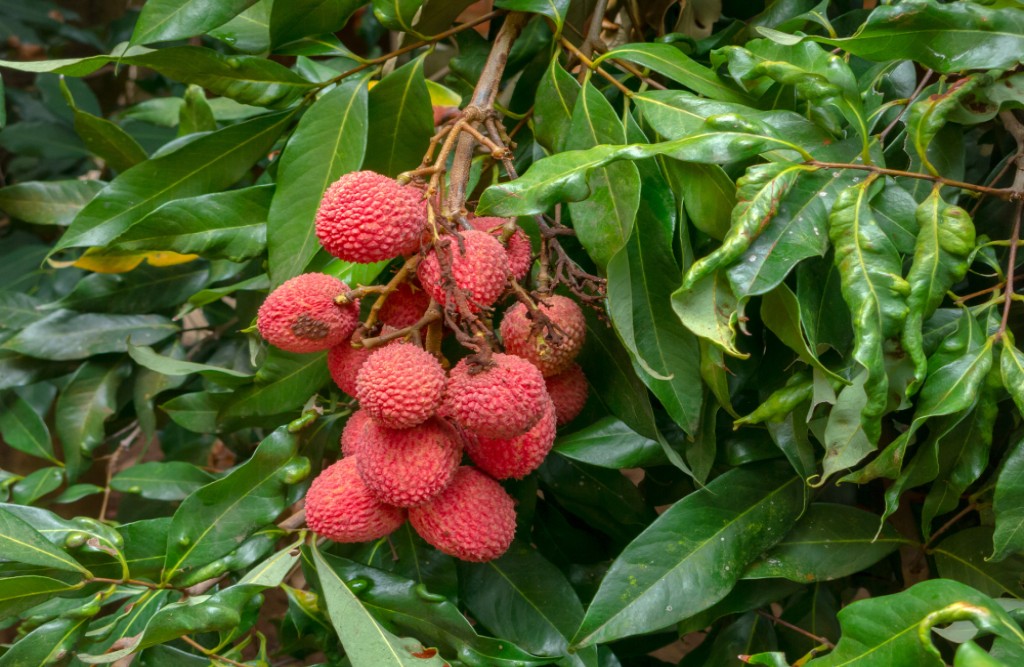
Lychee, often referred to as the "queen of fruits" due to its pink and red-hued fruits, is renowned not only in India but also globally for its delightful color, flavor, and quality. India holds the second position in lychee production worldwide, following China. Himachal Pradesh alone spans a total area of 4060 hectares dedicated to lychee cultivation, yielding 3385 metric tons of this fruit. Predominantly grown in Northern Bihar, Dehradun, Uttar Pradesh, Jharkhand, Punjab, and select regions of Himachal Pradesh, lychee cultivation is on the rise. Efforts are underway to enhance the quality of lychee fruits to meet international standards, alongside increasing orchard productivity. Commercial lychee cultivation involves grafting techniques, where shoots are meticulously prepared by removing thorns along with branches and then grafted onto rootstocks with rooted thorns, facilitating robust plant development. Proper care through grafting in nurseries or seedbeds is imperative to establish a greater number of shoots for optimal plant growth acceleration.
The production of lychee plants involves seedlings, rootstocks, scions, shoots, and grafting. In China, lychee has traditionally been prepared through grafting methods for years. Apart from grafting, another technique for lychee is grafting, which is now being commercially adopted in China, Vietnam, and other countries. To prepare a lychee plant, various locations such as open gardens and modern facilities like greenhouses, polyhouses, and mist chambers can be utilized. Plants prepared through grafting take 8-10 months, while those through grafting are ready in 1-2 years.
When selecting and planting saplings in the nursery, it's crucial to opt for the most effective cloning method. Maternal plants, chosen for their desirable traits, play a pivotal role in shaping the nursery's future and enhancing future yields. These maternal plants should faithfully represent their respective varieties and be adequately spaced apart. It's imperative to avoid any mixing and ensure there's room for new varieties and empty spaces. Additionally, saplings must be inspected to ensure they are free from diseases and pests.
The agro-shed or mist house should ideally cover a minimum area of 8 square meters or more, with a height of 3.8 meters and a width of 2.2 meters on both sides. A pathway should be established in the middle, with aisles formed for accessibility. The shed's walls should be constructed using bricks, reaching a height of 90 centimeters, and should be plastered on both the inside and outside surfaces. Installing fencing is essential to safeguard the saplings.
Lychee thrives successfully in deep loamy soil. It's advisable to use soil with a slightly acidic pH and incorporate mycorrhiza for optimal growth. Mycorrhiza helps in the formation of nodules on the roots, which are essential for the rapid and proper development of plants. If mycorrhiza is not available, soil can be obtained from around the roots of old trees and mixed with potting soil.
The riverbank alluvial soil is ideal for lychee plants as it provides a mix of other nutrients and mineral salts essential for plant growth. It's crucial for nutrients to be present in the correct proportions at all stages of plant development. Lychee plants are perennial in nature and thrive in regions with a subtropical to temperate climate. The fruit of the lychee is perennial.
It is crucial to use dry grass to cover the plants for protection. Small plants need safeguarding from fog, frost, and low temperatures. Ensure they receive sunlight from the southeast direction all day long. Shielding them from cold winter winds and hot summer winds is vital. Plant mango trees in rows facing the northwest direction, alternating with trees such as shisham, silver oak, or oak. In front of these rows, plant guava or mulberry trees.
Read More... The Secret of Successful Coconut Farming in India
Fertilizer Management: For one-year-old lychee plants, the recommended fertilizer quantities per plant are as follows: 10 kg of cow dung, 240 grams of CAN, or 120 grams of urea, or 190 grams of single superphosphate, and 50 grams of muriate of potash. For lychee plants aged 11 years, the required quantities per plant are 60 kg of cow dung, 2 kg or 800 grams of CAN, 1 kg or 400 grams of urea, 200 grams of single superphosphate, and 600 grams of muriate of potash. The same amount of fertilizers and nutrients should be applied to plants older than 11 years. Cow dung, phosphorus, and potassium fertilizers should be applied at the end of December. Divide the nitrogen dose into two equal parts and apply one part in February.
Major Pests and Control: